Coffee Roasting: An Art and Science Behind Your Perfect Cup
Coffee roasting is both an art and a science, with a significant impact on the flavor, aroma, and overall quality of the final cup of coffee. By skillfully manipulating heat, time, and other factors, coffee roasters transform green coffee beans into the rich, complex beverage that we know and love. In this article, we'll delve into the fascinating world of coffee roasting and explore the techniques and processes that create your perfect cup of coffee.
-
The Coffee Roasting Process: A Brief Overview Coffee roasting is the process of applying heat to green coffee beans to develop their flavor, aroma, and color. As the beans are heated, they undergo various chemical reactions, which cause them to release moisture, expand, and develop the characteristic brown color and enticing aroma of roasted coffee. The roasting process can be tailored to produce a range of roast levels, from light to dark, each with its unique flavor profile.
-
Roast Levels and Flavor Profiles The roast level has a significant impact on the flavor profile of coffee, and roasters must carefully control the roasting process to achieve the desired outcome. Light roasts generally have higher acidity, more complex flavors, and brighter, fruitier notes. Medium roasts offer a balance between acidity and body, with more pronounced sweetness and caramelization. Dark roasts have lower acidity, a heavier body, and more intense, smoky flavors resulting from the beans' extended exposure to heat.
-
Roasting Equipment and Techniques Various types of coffee roasting equipment are available, ranging from small home roasters to large commercial machines. The most common roasting methods include drum roasting, hot air roasting, and fluid bed roasting. Each technique offers its unique benefits, but all aim to evenly apply heat to the beans and carefully control the roasting process to achieve the desired flavor profile.
-
The Importance of Quality Green Beans The quality of the green coffee beans plays a crucial role in the final product's taste and aroma. Roasters must carefully select high-quality beans from reputable sources to ensure that they have the best raw materials for their craft. Factors such as the bean's origin, processing method, and freshness can all influence the coffee's final flavor and quality.
-
Mastering the Roasting Process To become a skilled coffee roaster, one must develop a deep understanding of the roasting process and the factors that influence the beans' transformation. Time, temperature, airflow, and bean moisture content are just a few of the variables that roasters must monitor and adjust during the roasting process. Developing an intuitive understanding of these factors and learning how to fine-tune the roasting process to achieve the desired results takes time, practice, and experience.
Coffee roasting is a fascinating blend of art and science, with skilled roasters carefully manipulating heat and other factors to create the perfect cup of coffee. From selecting high-quality green beans to mastering the roasting process, coffee roasting is a complex and rewarding craft that significantly impacts the flavor, aroma, and quality of your favorite beverage. So next time you enjoy a delicious cup of coffee, take a moment to appreciate the skill and dedication that goes into every roast.


